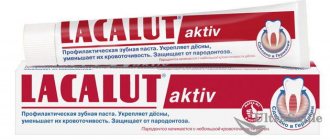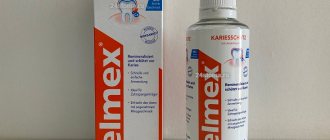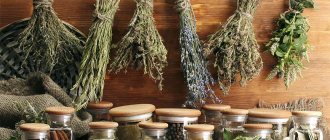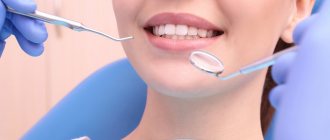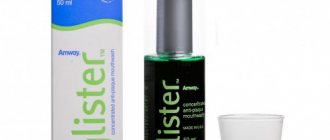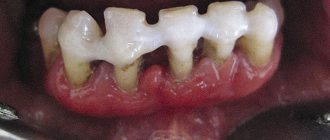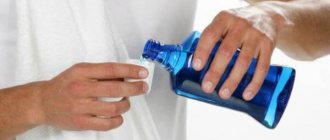Many centuries ago, our ancestors understood a simple truth - nature itself takes best care of human health. After all, for any disease there is sure to be a medicinal plant that will help improve the condition. Thanks to the experience of traditional healers, today we know many effective and safe recipes for all occasions. And the benefits from these natural remedies are often much greater than from expensive medications.
For example, oak bark, which has many beneficial qualities, is widely used in folk medicine. Based on this component, various recipes have been compiled that help stop uterine bleeding, cope with excessive sweating, and prevent bedsores. Oak bark is very useful in treating teeth and oral cavity. It is recommended for gingivitis, stomatitis, gumboil, and bad breath.
Causes of bleeding gums
If you are interested in the mechanism of how poor hygiene and gum inflammation lead to bleeding, it looks like this.
Plaque and tartar bacteria produce a large number of toxins and various pathogens that trigger a chain of inflammatory reactions in the gums. In particular, this leads to increased permeability and fragility of capillaries (which is due to the fact that blood appears precisely when brushing teeth), as well as to swelling, redness or cyanosis of the gingival papillae. In parallel with this, the process of desquamation (squamation) of epithelial cells of the gum mucosa intensifies, which leads to thinning of the epithelium. The latter further reduces the resistance of gums weakened by inflammation to mechanical stress, for example, when brushing teeth or chewing hard food. Therefore, when together: 1) fragility and increased permeability of capillaries, 2) thinning of the epithelium + 3) even completely normal mechanical stress, it ends in bleeding when brushing your teeth.
By the way, a very common symptom that accompanies bleeding gums is pain when brushing your teeth. The mechanism of its development is also associated with thinning of the epithelium of the gum mucosa and a decrease in the latter’s resistance to mechanical stress. And the conclusion that needs to be drawn from all of the above is that treatment should not be tied to the fight against a separate symptom of bleeding; it should consist in eliminating the main cause of gum inflammation, i.e. removal of microbial plaque and tartar.
Useful properties of oak bark
Oak bark has a wide range of useful characteristics, it perfectly heals wounds, is a natural antiseptic, anthelmintic, and actively inhibits the growth of pathogenic bacteria. The oak bark itself contains tannins, which have an astringent effect, resins, various acids, proteins and pectin, which actively help restore the protective functions of the body and restore the skin.
Oak bark, like the tree itself, is a powerful and unshakable natural protector of humans from various diseases.
When the human body is weakened, as a rule, the immune system is the first to suffer. When protection weakens, the first thing that suffers is the mucous membranes. The eyes begin to water, which leads to various complications; the nasopharynx is susceptible to attacks by various bacteria and microbes, which also leads to diseases. An unpleasant odor appears in the mouth, and when brushing your teeth, blood appears on the toothbrush. All this suggests that it is necessary to take measures to prevent diseases.
Factors predisposing to bleeding gums
If this is not the first time that you have experienced bleeding, this indicates that your gum inflammation is chronic and has been going on for quite a long time. In this case, when brushing your teeth, blood may appear and then disappear again (24stoma.ru). Typically, gums bleed only during exacerbations of chronic inflammation. Exacerbation of the inflammatory process most often occurs in the off-season and is associated with a decrease in immunity or the development of vitamin deficiency.
But we don’t want you to think that poor immunity or vitamin deficiency are the causes of exacerbations of gum inflammation and bleeding. The cause is still plaque bacteria. It’s just that local protective factors in the oral cavity (against the background of decreased immunity) no longer cope with the previous volume of toxins and pathogens released by microbial plaque on your teeth. Other predisposing factors may include mouth breathing and xerostomia, which contribute to an increase in the amount of plaque in the mouth.
Causes of periodontitis
Factors that provoke the disease include:
- unprofessional, illiterate dental treatment;
- illiterate prosthetics (wide crowns);
- mechanical gum injuries;
- inattentive oral care;
- disturbance of the rate of metabolic processes in the periodontium;
- malocclusion;
- reduced load on the dentogingival apparatus due to eating predominantly soft foods.
What diseases are bleeding gums a symptom of?
Bleeding gums can be either an independent disease or a symptom of another. There are three oral diseases that can lead to bleeding:
- Periodontal disease. With periodontal disease, it is not so much the gums that are damaged as the soft tissue around them. Due to the damage to these tissues, which dentists call periodontium, there is an increase in the amount of plaque on the teeth, which leads to microtrauma of the gums. With periodontal disease, tooth pockets do not form, and the gums themselves become inflamed quite rarely.
- Periodontitis. With periodontitis, both the gums and the soft tissue around them are damaged. The disease progresses very quickly. If left untreated, symptoms such as gradual destruction of the alveolar process, inflammation of the gums and soft tissues, formation of dental pockets (which often fester), and so on are observed. Periodontitis is relatively common.
- Gingivitis. Gingivitis causes damage to the gums. If gingivitis is not treated, it evolves into periodontitis.
Preparing a decoction for rinsing
The decoction is prepared quite simply:
You need to take 2 teaspoons of crushed oak bark, pour it with two glasses of water, boil, reduce the heat and simmer over low heat for about 5 minutes. Then the broth must be set aside until it cools completely. Strain the mixture and pour the medicinal part into a jar. Mouth rinsing should be done 3 to 5 times a day. It must be remembered that treatment must be carried out for 3 days, even if after the first rinse there is a noticeable improvement, rinsing must be continued. In advanced stages of gum inflammation, such procedures should be carried out for up to one week. Every day it is necessary to prepare a new decoction, so the treatment will be more effective and bring more benefits.
Treatment of stomatitis
In addition to toothache and gumboil, stomatitis is a common oral disease. This is a fairly common disease among children, since parents are not always able to be vigilant and remove dirty hands or a dirty toy from the child’s mouth in time. Stomatitis causes high fever, purulent ulcers are observed in the oral cavity, which hurt terribly and cause a lot of trouble not only for the baby, but also for his parents. In order to get rid of this disease, you need to brew 2 teaspoons of oak bark, add a teaspoon of medicinal chamomile or calendula, pour it all over with three glasses of boiling water and boil in a water bath for 5 minutes. Then cool the broth, strain and begin rinsing your mouth.
For tiny children, the problem of rinsing is quite relevant; parents should not give up the folk remedy, they just need to treat every wound in the mouth with this decoction. After some time, the baby will feel a little better, the main thing is not to give up and do everything quickly and collectedly. Treatment of stomatitis with oak bark will be more effective, since there are no proven remedies for children, and those medicines that are used everywhere are prescribed to children from the age of seven.
What to do if your gums bleed: treatment
If your gums bleed when brushing your teeth, treatment should be carried out by a periodontist (these doctors do not specialize in the treatment of gums). The most important thing to do at the first stage of treatment is to remove the causative factor in the development of gum inflammation, i.e. carry out ultrasonic cleaning of teeth from microbial plaque and tartar. This can only be done by a dentist. But the course of anti-inflammatory therapy following the cleansing can be carried out at home.
Why is periodontitis dangerous?
Periodontal tissues include not only the gums, but also the surface layer of the tooth root, the ligamentous apparatus, and the bone walls of the socket. All these tissues perform support-retaining, shock-absorbing, trophic, nutritional, and barrier functions. Inflammation of periodontal tissues provokes disruption of the intergingival junction, which causes loosening and tooth loss.
If not treated in a timely manner, periodontitis can lead to intoxication of the body, and, consequently, diseases of the cardiovascular system, infection of bone tissue, and the development of osteomyelitis.
Treatment at the dentist's office
Treatment of bleeding gums when brushing teeth includes removing plaque from enamel and tartar and rinsing deep periodontal pockets for periodontitis and periodontal disease. These manipulations are carried out by a specialist in the clinic’s office.
To remove dental plaque, ultrasonic cleaning is used, less often - the use of instruments and mechanical cleaning of the enamel. The number of sessions required depends on the complexity of the work and the amount of deposits.
Washing of periodontal pockets is carried out in chronic forms of periodontitis and periodontal disease. It helps remove pathogenic microbes, their waste products, pus and exudate. The solutions used have antibacterial, antimicrobial and anti-inflammatory effects.
Gum baths
Dentists say: in recent years, approaches to certain procedures have changed, in particular rinsing for diseases of the teeth and gums. What new do experts offer?
The story is told by Elena Vasilyevna Zoryan, Candidate of Medical Sciences, Associate Professor of the Department of General Dentistry and Anesthesiology of the Moscow State Medical and Dental University.
– Rinsing is a simple and familiar procedure. Could there really be any innovations in relation to it?
– Yes, no matter how surprising it sounds. Many of us take rinsing very lightly, in the traditional sense of the word, believing that the more often we do it, the better. This way you can clean the oral cavity and get rid of many harmful microorganisms that tend to settle there. This is of course true.
But the problem is much broader - the fact is that along with microbes we also wash away saliva. And it plays an important protective role and protects us from infection. In particular, it contains lysozyme, which itself has an antibacterial effect. As well as substances that inhibit the proliferation of various bacteria and other microorganisms. And by removing saliva, we lose all this protection.
In order not to be left alone with germs, you need to learn how to rinse your mouth correctly.
- How exactly?
– We usually do it this way: we put water in our mouth, rinse it, and then spit it out. This method is justified only in some situations, for example, when rinsing after eating. This allows you to clean your mouth and remove any remaining food. Or after brushing your teeth, when you need to wash off the toothpaste.
In cases where we use rinsing as a therapeutic procedure, we need to rinse differently. Take a solution containing the necessary medications into your mouth, hold it for a while on the side where there is inflammation or damage to the gum mucosa, and then spit it out. In medical parlance, this method of rinsing is called “oral baths.”
The temperature of the solution should be warm - about 40 degrees. Too hot water can cause an exacerbation of inflammation, and too cold water can narrow blood vessels and disrupt cell nutrition.
In one session, it is effective to do 5-7 rinses for 30-40 seconds. If the inflammation is in the acute stage, then it is advisable to rinse frequently. When the inflammation is relieved, 3-4 times a day is enough.
– There is another option for local treatment – applications. In what cases are they used and can they be a replacement for rinses?
– Applications are the application of a special ointment, gel and solution directly to the damaged area. They can be used either independently or in addition to rinses.
When treating small children, rinsing is not used. Due to their age, they cannot rinse their mouth; they simply take water and swallow it. Therefore, rinsing with medicinal solutions in the first years of life is not recommended; at best, irrigation is used. Applications are often a real way out of the situation. In this case, the doctor can select the dosage form - solution, gel, ointment - individually.
– Are there any other cases when rinsing is undesirable?
– If we are talking about rinsing with medications, then we need to look into each individual case. How does this drug work and for what purpose is it used in this case? Any drug can cause not only allergies, but also other side effects. Therefore, be careful and do not start using it without consulting your doctor.
This is especially true for rinsing with antibacterial, antiviral and antifungal agents. We often use antiseptics ourselves, such as chlorhexidine.
It is effective, but has a number of side effects. In particular, it causes staining of teeth, promotes the deposition of tartar and temporarily disrupts sensitivity and taste.
– At one time it was popular to rinse with an “iodine” solution: salt, soda, iodine, water. But then messages began to appear that this should not be done. What is the situation now?
– You should be careful with iodine. It is indeed a very good antiseptic, but not for everyone and not always useful.
For example, some people experience increased sensitivity to iodine even when first used. Therefore, before rinsing, especially for children, be sure to conduct a control test.
Iodine preparations should also be used with caution by those who have problems with the thyroid gland, as well as pregnant and lactating women.
– What rinses can you do yourself? For example, if a wound appears in the mouth, how to treat it?
– You can safely use herbal preparations – infusions and decoctions. Preparations of chamomile, sage, and oak bark have a good anti-inflammatory effect.
Complex preparations 5 are being created based on plant raw materials, which are convenient because they do not need to be prepared, like infusions and decoctions. For example, Rotokan. Dilute 5–10 drops in a glass of warm water and take baths two to three times a day.
– These remedies are safe, but they do not always help. Are there any more effective drugs?
– There are many such drugs, and dentists know about them. And more recently, a new drug for topical use has appeared - Parodontocide. This drug combines herbal and chemical components and has not only anti-inflammatory and analgesic, but also antibacterial and antifungal effects. This makes it highly effective against inflammation, bleeding gums, and diseases such as gingivitis and periodontitis. What sets Parodontocid apart from many other drugs used for topical use.
– For what diseases are rinses with Parodontocide recommended?
– First of all, this drug is prescribed for inflammation and bleeding of the gums, in the treatment of gingivitis, periodontitis and periodontal disease.
Periodontocide is used daily as a rinse of 15–20 drops in 1/3 glass of water in the morning and evening for 3 minutes. After rinsing the mouth, a few undiluted drops of the drug can be applied to the gums for subsequent massage in the direction from the gums to the top of the teeth. The course of treatment is 4 weeks, after which you should take a break.
It is also very effective for inflammatory diseases of the oral mucosa - stomatitis and tongue - glossitis.
It is known that diseases of the gums and mucous membranes cause a lot of inconvenience. In addition to pain and increased sensitivity, bad breath can often be bothersome. Periodontocide copes well with this problem, which also helps improve the quality of life.
– What about caries?
– On the one hand, if such a problem already exists, then you need to go to the dentist and treat your bad teeth. Rinsing alone is not enough.
But on the other hand, Parodontocid contains sodium fluoride, which forms an acid-resistant compound with calcium salts. In addition, fluoride preparations have a bactericidal effect against acid-forming microorganisms that contribute to the development of caries and strengthen tooth enamel.
– Is it possible to use Parodontocid for the purpose of prevention?
– Yes, this drug is definitely recommended to be used to prevent diseases. In some cases this is justified, for example after surgery.
Gels and toothpastes for bleeding
You should choose a toothpaste based on what is causing your gums to bleed. The composition may contain different components: potassium chloride, sodium sulfate, vitamins, medicinal plants, etc.
The most effective and popular means to solve the problem:
- SPLAT Professional Active is a Russian toothpaste, its distinctive feature is its black color. It has several actions at once - antiseptic, hemostatic. The main components included in the composition are skullcap, spirulina extract, and bergenia extract.
- Lacalut Activ is a whole complex that includes a toothbrush, toothpaste and mouthwash. Aluminum cations are used as a basis.
- Parodontax Classic – contains extracts of medicinal herbs. The pasta is produced not in our country, but in the UK.
- Forest balsam is another domestic product that contains many components of plant origin. There is sea buckthorn essential oil, St. John's wort, chamomile and more.
Recommended toothpaste for treatment
Dental gels are no less effective. It is recommended to use Cholisal, Parodium, Solcoseryl, Metrogil Dent, etc.
Interesting!
It is recommended to change toothpastes periodically, this way you can achieve comprehensive care.
Whitening pastes should never be used for bleeding gums. The thing is that they can irritate the gums, thereby further aggravating the situation. In the video in this article you can learn in more detail about which toothpastes and gels are useful for this problem.
How to rinse an inflamed gum, what medications will help with inflammation
It is first necessary to determine what is the cause of the swelling and redness, since this determines the choice of medicine.
All of them are divided into three categories, in accordance with the main effects they provide:
- Antiseptics and preparations containing antibiotics. They are designed to prevent the spread of bacterial infection. Most often prescribed by dentists for serious illnesses or after operations on the gums, including after nerve removal and wisdom teeth extraction.
- Anti-inflammatory. They are designed to relieve inflammation, reduce pain, eliminate swelling and redness.
- Solutions that combine the two above effects, that is, a combination of them. They are the most effective.
Antiseptics for rinsing
Mouth rinse
To rinse the mouth, you should take products with antibacterial and anti-inflammatory effects. In order to enhance overall healing, they are usually used as a supplement.
So, what do dentists recommend:
- Miramistin 0.01%. The drug is especially effective for herpes infections, has a calming and antimicrobial effect.
- Stomatophyte – contains medicinal herbs and alcohol. Recommended for use in the development of gingivitis and periodontal disease.
- Polyminerol – stops bleeding, accelerates regeneration processes.
- Chlorhexidine, concentration not more than 0.05%. This is an antibacterial agent used for inflammatory processes. In addition, dentists recommend rinsing your mouth with it after tooth extraction.
- Chlorophyllipt is based on an extract of eucalyptus leaves. It is prescribed when the oral cavity is affected by pathogenic staphylococci.
- Maraslavin. Contains wormwood herb, savory, black pepper. Helps relieve pain, eliminates allergy symptoms.
- Periodonticide. It contains a large number of medicinal herbs, due to this it has a good anti-inflammatory effect.
To achieve the desired result, rinses should be used in a course. Moreover, one product cannot be used for more than a month. The thing is that many bacteria can develop resistance.
Main causes of gum inflammation
The most common causes of gum inflammation are:
- formation of tartar and lack of measures to remove it;
- systemic diseases - those that affect the entire body;
- active proliferation of pathogenic bacteria in the oral cavity.
Typically, the development of pathology begins with the formation of dental plaque, which is formed from compacted plaque. A few days of neglecting oral hygiene are enough for the plaque to harden sufficiently.
Exposure of plaque to minerals from saliva triggers the formation of tartar. For this reason, stones are especially often formed on the inside of the lower dentition, since the salivary ducts under the tongue are located there. The presence of stones has a detrimental effect not only on the teeth, but also on the tissues surrounding them.
There are also secondary causes of gum disease:
- hereditary predisposition;
- consequences of injury;
- consequences of improper medical treatment;
- inflammatory diseases of nearby organs (tonsillitis, sinusitis, etc.);
- orthopedic structures made of low-quality materials or incorrectly executed;
- imbalance of substances in saliva;
- smoking;
- alcohol abuse;
- severe stress;
- hormonal imbalances;
- structural features of teeth and gums.
Often, after suffering severe viral diseases, as well as after allergies or fungal infections, the immune system is greatly weakened. This can also become an impetus for the development of periodontal disease. In case of gum inflammation, the causes and treatment must be determined by a doctor in order to prevent chronicity, as well as further spread of the pathological process.
Folk remedies for bleeding gums
After consulting with your doctor, you can also use some traditional medicine that eliminate existing bleeding no worse than medications.
1. Oak bark. This is one of the simplest and at the same time effective means of treating bleeding gums. This bark is rich in tannins, which strengthen the gums and prevent their bleeding. For treatment, just take 1 tbsp. crushed oak bark, pour 100 ml of boiling water and put on fire. Keep the product on the fire for 7 minutes, then remove and let it cool. Rinse your mouth with this medicine 2 times a day.
2. Chamomile. This flower boasts excellent anti-inflammatory properties, which eliminates the cause of gingival bleeding caused by the inflammatory process. Take 1 tbsp. chamomile flowers and load into a thermos. Fill the healing plant with 250 ml of boiling water, close the lid of the thermos and leave the product for 4 hours. Let it cool, and then strain the medicine and you can rinse your mouth with it after meals 3 times a day.
3. Sage. Another natural remedy that is extremely beneficial for oral health is sage. To get rid of bleeding gums you will need to take 2 tbsp. dry sage leaves and irritate them with 400 ml of boiling water. Leave the finished mixture to infuse for half an hour, then strain and rinse your mouth with the mixture twice a day, morning and evening.
Let us only add that the considered folk remedies should not be the only medicines in the fight against bleeding gums. They can only be used in combination with medications prescribed by a doctor.
Types of inflammatory and dystrophic gum diseases
Inflammatory manifestations include:
- Gingivitis
- Periodontitis
Dystrophic manifestations include:
Gingivitis: signs, causes and treatment
Gingivitis is the first stage of inflammation, in which the integrity of the periodontal junction has not yet been compromised. This disease can be identified by the following signs:
- Swelling of the gums.
- Blood while brushing teeth.
- Pain when eating cold, hot or solid foods.
Improper brushing of teeth, errors during fillings and dentures, improper bite – all this can cause gingivitis. By the way, this is one of the most popular problems that pediatric dentists encounter.
Treatment of gingivitis involves a set of procedures carried out in a dental clinic and at home. If there is dental plaque, it is necessary to carry out ultrasonic cleaning. In addition, you should pay more attention to hygiene: brush your teeth properly and use antibacterial agents.
Periodontitis
Periodontitis is a pathology that occurs as a result of advanced gingivitis. In this case, the swelling of the gums becomes even stronger, they begin to bleed frequently. If left untreated, infection and pus may form. As a result, the bone tissue begins to atrophy, and this leads to increased sensitivity of the teeth, their mobility, and sometimes even loss.
Treatment of periodontitis is prescribed taking into account the course of the disease. At first, procedures such as removing plaque from the enamel and regular brushing of teeth with antiseptic agents may be sufficient. In more serious situations, when the infection has penetrated deep into the bone tissue, surgery may be necessary:
- Partial gum excision.
- Cleaning periodontal pockets.
- Implantation of bone tissue substitutes.
Periodontal disease
Periodontal disease is a systemic disease. As a rule, it is typical for elderly patients. Inflammatory-dystrophic manifestations in this case are concentrated in the periodontal tissue.
Periodontal disease develops at a leisurely pace, gradually erasing tooth enamel. The presence of this disease can be determined by exposed tooth roots and cervical chips of tooth enamel. In most cases, no pain occurs, but if you ignore the problem, you can “lose” your teeth.
To eliminate periodontal disease, it is necessary not only to observe and treat the dentist, but also to related specialists.
Treatment of inflammation at home
The course of treatment of teeth and gums is always selected taking into account the individual characteristics of the disease:
- A type of inflammatory process.
- Neglect of pathology.
- Patient's age.
For example, in adult patients, inflammatory processes most often occur due to chronic diseases. To eliminate the problem, as a rule, pharmaceutical products are required - antiseptics, gels, ointments, antibiotics, toothpastes. If a child’s gums become inflamed, this is almost always associated with teething and herbal medicine, that is, rinsing with herbal decoctions and using other methods of traditional medicine, is sufficient for treatment.
How can diet help treat gums?
If your gums bleed when brushing your teeth, treatment should begin immediately. In addition to drug therapy, it is important to maintain proper nutrition. The patient needs to reduce the consumption of sugar and fatty foods. Regardless of age, it is important to get enough vitamins. Doctors recommend including in your diet: vegetables, fruits, fish, cheeses, cottage cheese. The dentist may prescribe a multivitamin supplement.
For treatment to be effective, you cannot exclude from your diet food containing calcium, phosphorus, and vitamins: C, E, B1 and B2. These components strengthen teeth and soft gum tissue. It is forbidden to eat spicy, sour foods. It irritates the mucous membrane. You should also not eat crackers, caramel, nuts, etc. When chewed, these products can injure the gums, after which bacteria will enter the wounds and the inflammatory process will begin.
In addition, doctors urge you to stop smoking and drinking alcohol.
Benefits of mouthwash
Regular use of modern mouth rinses provides:
1
2
prevention, maintenance of oral health and bleeding gums
3
additional cleansing of the mucous membrane, surface of teeth and hard-to-reach places from food debris, bacteria and dead epithelial cells
4
5
Elimination of tooth sensitivity
6
whitening effect (removing traces of nicotine, food and drinks).
Thus, rinses help maintain the health of teeth and periodontal tissues, called periodontium. All this ensures a beautiful smile for many years.

